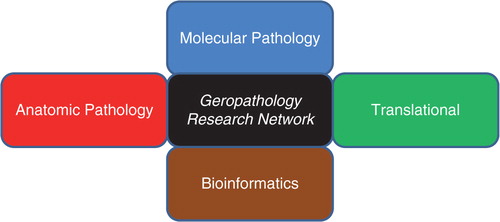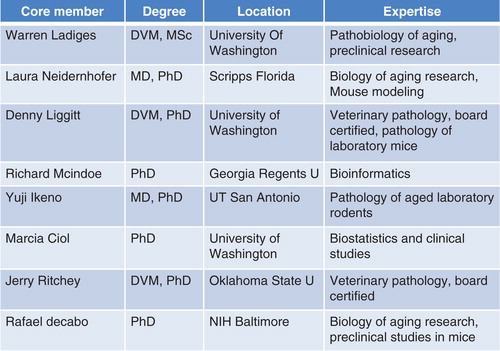Geriatric scientists and pathologists convened in Seattle, WA, on May 7 and 8, 2015, for the first annual symposium of the Geropathology Research Network. The network is a newly formed consortium () supported by the United States National Institutes of Health (NIH). The mission of the network is to develop ways to translationally enhance the level, scope, and consistency of molecular and anatomic pathology assessment in old animals involved in aging studies using a network of pathologists and scientists with expertise in the pathobiology of aging.
Dr. Felipe Sierra, Director of the Division of Aging Biology at NIH, started the symposium by giving an introductory presentation on the Geroscience Initiative and how the Geropathology Research Network was a key component in plans for helping move the initiative forward. Follow-up presentations were made describing interactive partners including the Geroscience Project by Dr. James Kirkland, Mayo Clinic; the Dog Longevity Project by Dr. Daniel Promislow, University of Washington; and the Intervention Testing Program by Dr. Rich Miller, University of Michigan. These presentations ended with a session devoted to future funding strategies, which included discussions on the advantages of a large initiative approach versus a more focused project-driven approach, and sources of possible funding including NIH, foundations and other private groups, international entities, and commercial corporations.
Working groups () gave presentations describing their goals and objectives and then met in separate sessions to discuss ways of standardizing tissue collection and processing for molecular and anatomic pathology assessments. A translational working group met to discuss ways of using pathology assessment to enhance the value of physiology measurements, with a specific interest in the characterization of frailty in the mouse. The working groups will be publishing follow-up consensus papers in this journal.
Fig. 2 The Geropathology Research Network carries out its aims and objectives with four working groups: Molecular Pathology, Translational, Anatomic Pathology, and Bioinformatics.

The symposium ended with scientific sessions on 1) Navigating drug development and translation in an academic environment; 2) Aging and health span in consomic mice; 3) Cardiac function, proteomics, and aging interventions; 4) Women's health and clinical aging studies; 5) Preclinical longevity studies in mice; 6) Preclinical anti-aging bioenergetics study in mice; and 7) Clinical anti-aging bioenergetics transition study.
The next meeting will be a workshop that will focus on the pathology of frailty in the mouse that will be held in conjunction with the Gerontological Society of America annual meeting in Orlando, FL, on November 18–22, 2015. The next scientific symposium will be in Washington, DC, in March 2016.
Editor-in-Chief

